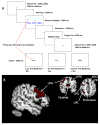Dimensionality of brain networks linked to life-long individual differences in self-control
- PMID: 23340413
- PMCID: PMC3555568
- DOI: 10.1038/ncomms2374
Dimensionality of brain networks linked to life-long individual differences in self-control
Abstract
The ability to delay gratification in childhood has been linked to positive outcomes in adolescence and adulthood. Here we examine a subsample of participants from a seminal longitudinal study of self-control throughout a subject's life span. Self-control, first studied in children at age 4 years, is now re-examined 40 years later, on a task that required control over the contents of working memory. We examine whether patterns of brain activation on this task can reliably distinguish participants with consistently low and high self-control abilities (low versus high delayers). We find that low delayers recruit significantly higher-dimensional neural networks when performing the task compared with high delayers. High delayers are also more homogeneous as a group in their neural patterns compared with low delayers. From these brain patterns, we can predict with 71% accuracy, whether a participant is a high or low delayer. The present results suggest that dimensionality of neural networks is a biological predictor of self-control abilities.
Conflict of interest statement
The authors have no competing financial interests to report.
Figures






Similar articles
-
Engagement of large-scale networks is related to individual differences in inhibitory control.Neuroimage. 2010 Nov 1;53(2):653-63. doi: 10.1016/j.neuroimage.2010.06.062. Epub 2010 Jun 30. Neuroimage. 2010. PMID: 20600962 Free PMC article.
-
Individual differences in working memory capacity are reflected in different ERP and EEG patterns to task difficulty.Brain Res. 2015 Aug 7;1616:146-56. doi: 10.1016/j.brainres.2015.05.003. Epub 2015 May 11. Brain Res. 2015. PMID: 25976774
-
Key Brain Network Nodes Show Differential Cognitive Relevance and Developmental Trajectories during Childhood and Adolescence.eNeuro. 2018 Jul 11;5(4):ENEURO.0092-18.2018. doi: 10.1523/ENEURO.0092-18.2018. eCollection 2018 Jul-Aug. eNeuro. 2018. PMID: 30073200 Free PMC article.
-
Working memory delay activity predicts individual differences in cognitive abilities.J Cogn Neurosci. 2015 May;27(5):853-65. doi: 10.1162/jocn_a_00765. Epub 2014 Dec 1. J Cogn Neurosci. 2015. PMID: 25436671 Free PMC article.
-
Short-time windows of correlation between large-scale functional brain networks predict vigilance intraindividually and interindividually.Hum Brain Mapp. 2013 Dec;34(12):3280-98. doi: 10.1002/hbm.22140. Epub 2012 Jun 27. Hum Brain Mapp. 2013. PMID: 22736565 Free PMC article.
Cited by
-
Resilience and amygdala function in older healthy and depressed adults.J Affect Disord. 2018 Sep;237:27-34. doi: 10.1016/j.jad.2018.04.109. Epub 2018 Apr 25. J Affect Disord. 2018. PMID: 29754022 Free PMC article.
-
Caudate responses to reward anticipation associated with delay discounting behavior in healthy youth.Dev Cogn Neurosci. 2014 Jan;7:43-52. doi: 10.1016/j.dcn.2013.10.009. Epub 2013 Nov 7. Dev Cogn Neurosci. 2014. PMID: 24309299 Free PMC article.
-
Neuromarkers of fatigue and cognitive complaints following chemotherapy for breast cancer: a prospective fMRI investigation.Breast Cancer Res Treat. 2014 Sep;147(2):445-55. doi: 10.1007/s10549-014-3092-6. Epub 2014 Aug 21. Breast Cancer Res Treat. 2014. PMID: 25138546 Free PMC article.
-
Biomarkers for the Rich and Dangerous: Why We Ought to Extend Bioprediction and Bioprevention to White-Collar Crime.Crim Law Philos. 2019;13(3):479-497. doi: 10.1007/s11572-018-9477-6. Epub 2018 Aug 10. Crim Law Philos. 2019. PMID: 31404215 Free PMC article.
-
Cortical Volume in the Right Cingulate Cortex Mediates the Increase of Self-Control From Young Adult to Middle-Aged.Front Behav Neurosci. 2022 Apr 1;16:723786. doi: 10.3389/fnbeh.2022.723786. eCollection 2022. Front Behav Neurosci. 2022. PMID: 35431826 Free PMC article.
References
-
- Eigsti IM, et al. Predicting cognitive control from preschool to late adolescence and young adulthood. Psychol Sci. 2006;17:478–484. - PubMed
-
- Mischel W, Shoda Y, Rodriguez ML. Delay of gratification in children. Science. 1989;244:933–938. - PubMed
-
- Shoda Y, Mischel W, Peake PK. Predicting adolescent cognitive and self-regulatory competences from preschool delay of gratification - indentifying diagnostic conditions. Dev Psychol. 1990;26:978–986.
-
- Yourganov G, Schmah T, Small SL, Rasmussen PM, Strother SC. Functional connectivity metrics during stroke recovery. Arch Ital Biol. 2010;148:259–270. - PubMed
Publication types
MeSH terms
Grants and funding
LinkOut - more resources
Full Text Sources
Other Literature Sources

